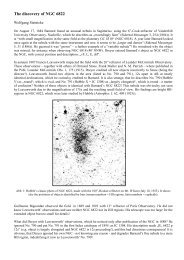John Louis Emil Dreyer – A Short Biography
John Louis Emil Dreyer – A Short Biography
John Louis Emil Dreyer – A Short Biography
Create successful ePaper yourself
Turn your PDF publications into a flip-book with our unique Google optimized e-Paper software.
existed (though with astrological content), a new name was chosen. Lord Lindsay, the owner of Dun Echt<br />
Observatory, financially supported the project, but obviously the enthusiastic publishers had underestimated the<br />
international competition in the shape of the Astronomical Journal, Bulletin Astronomique and Astronomische<br />
Nachrichten (which was effectively remodelled by Krüger in Kiel). Thus, after a notable initial success, Copernicus<br />
was abandoned in 1884, after only three volumes.<br />
Alongside the regular work at Dunsink, <strong>Dreyer</strong> was able to continue his cataloguing of non-stellar objects.<br />
During his first period, until the end of 1879, he finished the publication of the Birr Castle observations; Lawrence<br />
Parsons had left him all of the necessary records and Ball, as a former ‘Rosse man’, of course supported this task.<br />
Armagh Observatory<br />
With the death of Thomas Romney Robinson on 28 February 1882 the office of the Director of Armagh<br />
Observatory became vacant. 5 He was in charge for 59 years, a unique record. <strong>Dreyer</strong> was under discussion as a<br />
possible successor and traditionally it was up to the Royal Astronomer in Greenwich to render an official<br />
‘certification of fitness’. William Christie stated on 9 May 1882 ‘I have much pleasure in stating that I consider<br />
Mr. J. L. E. <strong>Dreyer</strong> a fit and proper person for the post of Astronomer of the Armagh Observatory.’ 6 On the<br />
following day, a formal offer was sent to the 30-year-old <strong>Dreyer</strong>. After visiting Armagh, he eventually accepted on<br />
22 May, and on 16 June was appointed as the new Director of Armagh Observatory. 7 Owing to an urgent<br />
refurbishment of the observatory, <strong>Dreyer</strong> could not move into his new home until 31 August 1882. The site is a bit<br />
off the town centre on the wooded, 70-m-high College Hill. The main building offered a commodious flat (Fig. 3).<br />
Three children were born there. The first was George Villiers <strong>Dreyer</strong> on 27 February 1883, making a career at the<br />
Royal Navy. The two others, William Lloyd and Margaret Ida (born 17 May 1885 and 5 September 1887), died<br />
when at the early age of three and one, respectively. In 1885 <strong>Dreyer</strong> became a British citizen.<br />
Fig. 3: <strong>Dreyer</strong> at Armagh Observatory in about 1890 (Armagh Obs.).<br />
As little as six weeks after <strong>Dreyer</strong> had moved in, he had to write his first annual report. In 1882 he had been<br />
awarded his doctorate degree from Copenhagen University for his work on the constant of precession. 8 It was<br />
particularly appreciated by the ‘Pope’ of celestial mechanics, Simon Newcomb, who was normally feared for his<br />
critical judgement.<br />
5<br />
Armagh, now belonging to Northern Ireland, lies about 100 km north of Dunsink; see McKenna (1967): 285<strong>–</strong>287, Michaud (1983);<br />
McFarland (1990).<br />
6<br />
Bennett (1990): 155.<br />
7<br />
<strong>Dreyer</strong>’s activity in Armagh was described in detail by Patrick Moore (Moore 1967).<br />
8 <strong>Dreyer</strong> (1882).











![SFB2011 Zeit [Kompatibilitätsmodus]](https://img.yumpu.com/4636501/1/190x135/sfb2011-zeit-kompatibilitatsmodus.jpg?quality=85)